The Starliner commercial crew capsule is undergoing drop tests to qualify it for human spaceflight missions. NASA Astronauts Suni Williams and Eric Boe could both eventually be assigned to ride in a Starliner, or a SpaceX Dragon crew capsule, once both commercial crafts are certified for human spaceflight. Wednesday, Oct. 25, 2017
-
Starliner test capsule is hoisted high on the gantry at NASA Langley Research Center, six plump airbags secured to its underbelly.
Week after week, it’s dropped to the ground, the airbags absorbing the weight of the spacecraft and cushioning the thud for the two test dummies strapped inside.
Soon enough, there will be real astronauts aboard a real Starliner, returning to Earth after a spell aboard the International Space Station.
They could even be veteran astronauts Sunita “Suni” Williams and Eric Boe, who flew to Hampton Roads from Johnson Space Center in Houston to observe their first drop test of a CST-100 Starliner, a commercial crew capsule being developed by Boeing for low-Earth orbit NASA missions.
“There’s actually two test dummies inside the spacecraft today for part of the test,” Williams said Wednesday, “and we were joking around that we should jump in there.”
A former naval aviator, Williams flew space shuttle missions and in 2012 became the second woman to assume command of the space station.
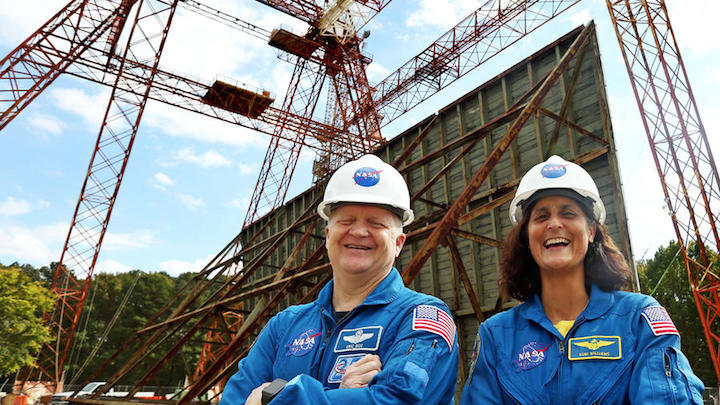
From left: NASA astronauts Eric Boe and Suni Williams pose for photograph at NASA Langley's gantry on Wednesday, Oct. 25, 2017. The Starliner commercial crew capsule is undergoing drop tests to qualify it for human spaceflight missions. Williams and Boe could both eventually be assigned to ride in a Starliner, or a SpaceX Dragon crew capsule, once both commercial crafts are certified for human spaceflight.
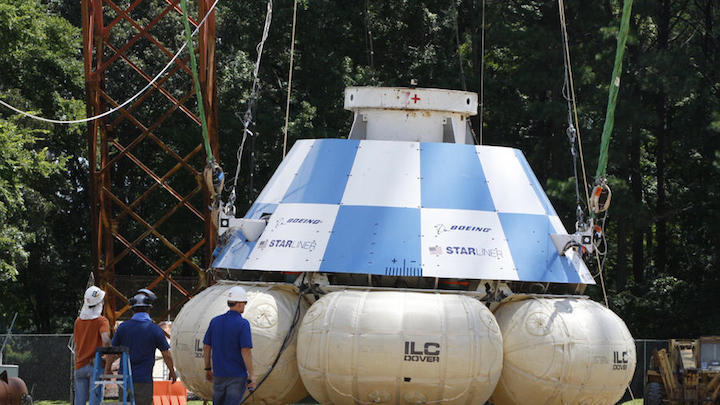
The Starliner commercial crew capsule is undergoing drop tests to qualify it for human spaceflight missions. NASA Astronauts Suni Williams and Eric Boe could both eventually be assigned to ride in a Starliner, or a SpaceX Dragon crew capsule, once both commercial crafts are certified for human spaceflight. Wednesday, Oct. 25, 2017.
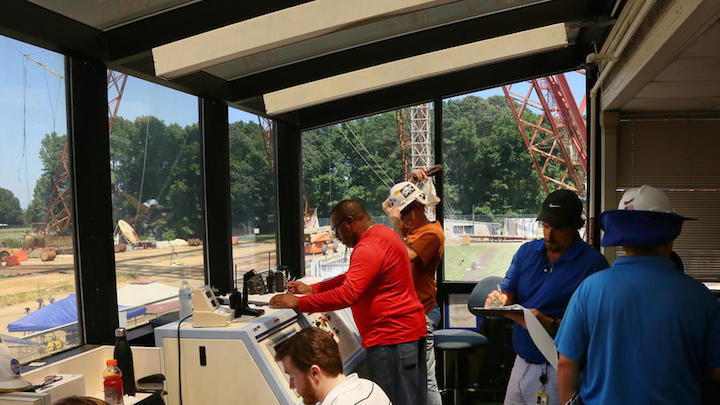
The Starliner commercial crew capsule is undergoing drop tests to qualify it for human spaceflight missions. NASA Astronauts Suni Williams and Eric Boe could both eventually be assigned to ride in a Starliner, or a SpaceX Dragon crew capsule, once both commercial crafts are certified for human spaceflight. Wednesday, Oct. 25, 2017.
The Starliner commercial crew capsule is undergoing drop tests to qualify it for human spaceflight missions. NASA Astronauts Suni Williams and Eric Boe could both eventually be assigned to ride in a Starliner, or a SpaceX Dragon crew capsule, once both commercial crafts are certified for human spaceflight. Wednesday, Oct. 25, 2017.
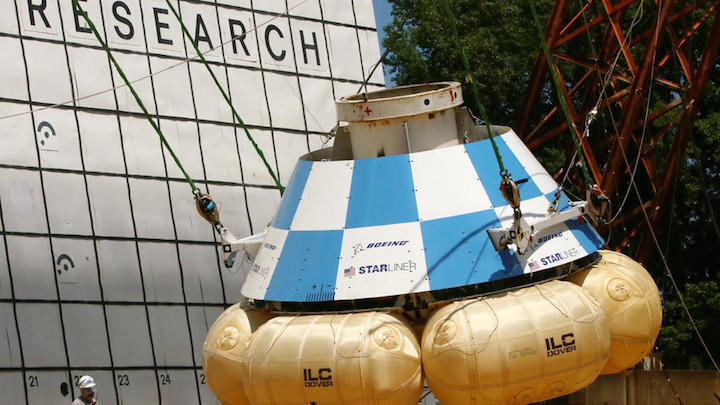
The Starliner commercial crew capsule is undergoing drop tests to qualify it for human spaceflight missions. NASA Astronauts Suni Williams and Eric Boe could both eventually be assigned to ride in a Starliner, or a SpaceX Dragon crew capsule, once both commercial crafts are certified for human spaceflight. Wednesday, Oct. 25, 2017.
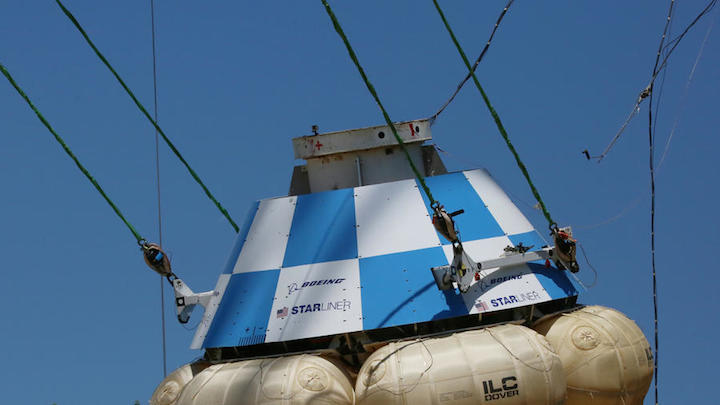
The Starliner commercial crew capsule is undergoing drop tests to qualify it for human spaceflight missions. NASA Astronauts Suni Williams and Eric Boe could both eventually be assigned to ride in a Starliner, or a SpaceX Dragon crew capsule, once both commercial crafts are certified for human spaceflight. Wednesday, Oct. 25, 2017.
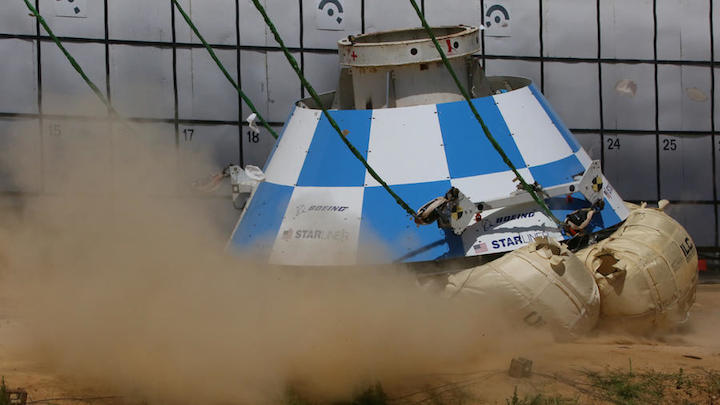
The Starliner commercial crew capsule is undergoing drop tests to qualify it for human spaceflight missions. NASA Astronauts Suni Williams and Eric Boe could both eventually be assigned to ride in a Starliner, or a SpaceX Dragon crew capsule, once both commercial crafts are certified for human spaceflight. Wednesday, Oct. 25, 2017.
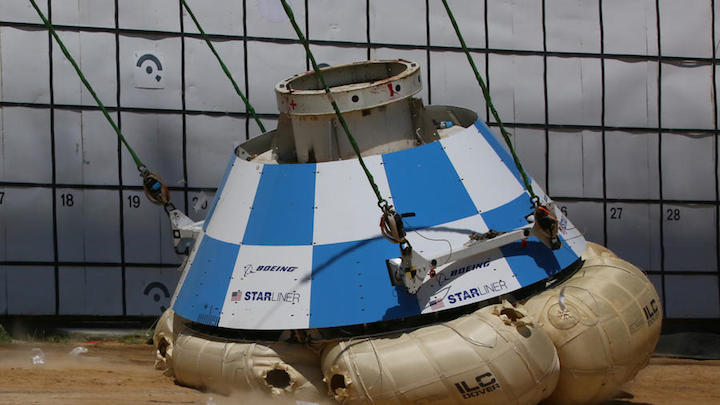
The Starliner commercial crew capsule is undergoing drop tests to qualify it for human spaceflight missions. NASA Astronauts Suni Williams and Eric Boe could both eventually be assigned to ride in a Starliner, or a SpaceX Dragon crew capsule, once both commercial crafts are certified for human spaceflight. Wednesday, Oct. 25, 2017.
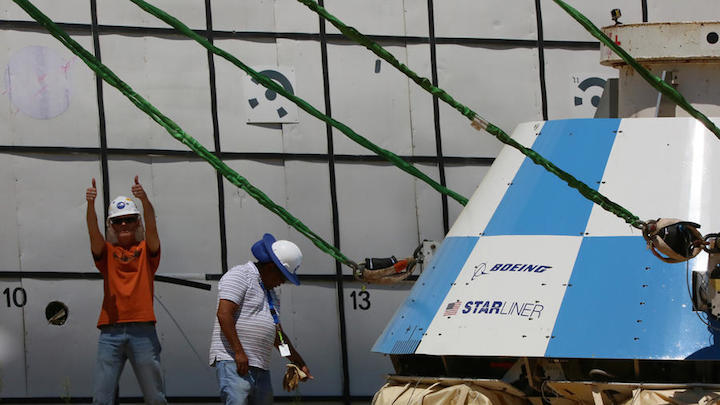
The Starliner commercial crew capsule is undergoing drop tests to qualify it for human spaceflight missions. NASA Astronauts Suni Williams and Eric Boe could both eventually be assigned to ride in a Starliner, or a SpaceX Dragon crew capsule, once both commercial crafts are certified for human spaceflight. Wednesday, Oct. 25, 2017.
-
She and Boe are among four experienced astronauts assigned to NASA’s Commercial Crew Program to help Boeing and SpaceX develop commercial vehicles for human spaceflight
As such, they’ve been test subjects for spacesuits, worked in simulators, prodded Boeing engineers and advised on the Starliner’s interior and technologies.
“They have a lot of expertise with their spacecraft,” said Williams. “But we have a lot of collective expertise with putting a human in that spacecraft.”
“It’s a really exciting time for us,” said Boe, a retired U.S. Air Force colonel who also has flown space shuttle missions to the ISS. “Because, if you’re lucky, as a test pilot you get to work on new airplanes. And now we have new spaceships that we’re working on.”
Big ocean, little capsule
For weeks now, the Starliner has been undergoing drop tests at the gantry to qualify for land landings. Wednesday’s marked the 11th test of 14 planned through the end of the year.
“It’s performing very well,” said Preston Ferguson, test lead for Boeing. “It’s the first U.S. capsule to be able to land on land, so the airbag system that we have is dual use — it can land both on land and on water.”
A water landing would be used in “off-nominal” or abort situations, he said. Nominally, the craft will re-enter from space, then waft toward solid ground under parachutes to land at one of several pre-selected sites, such as Edwards Air Force Base in California or White Sands Space Harbor in New Mexico.
Williams and Coe said there are benefits and drawbacks to either type of landing, but they preferred land over water.
Williams speaks from experience: She has already made a land landing aboard a Russian Soyuz capsule.
“When you land on land, maybe it’s a little bit harder,” Williams said. “But when you’re coming down at high speed, the water’s hard, too.
“Landing on water, if somebody’s right there to rescue you and they know exactly where you’re coming down, that works. And we’ve shown that works with the Apollo program. But, landing on water — I’m a Navy guy, there’s a big ocean out there and it’s a little space capsule and there’s some definite risks to that, too.
“Landing on the Soyuz, you open the hatch, you smell the grass, you’re not in a huge rush to get out or stay in. You know you’re in a solid place and you know you can take your time getting out and the rescue forces will be there eventually, if they’re not there knocking on the door.”
Stress the capsule
The Starliner’s airbags are tucked under the heat shield and specially designed to protect the craft, said NASA Langley senior aerospace engineer Richard Boitnott in a phone call Tuesday.
After re-entry, the heat shield will be jettisoned and the parachutes deployed to begin to ease the vehicle down, he said. As the craft hits the ground, the main bags will vent and absorb the initial energy of impact, while smaller “anti-bottoming” bags inside those main bags act to protect it even further.
Then the capsule will be retrieved, refurbished over six months and used over again — up to 10 times throughout its operational life.
NASA awarded Boeing up to $4.2 billion in September 2014 under its Commercial Crew Program to build, test and fly the Starliner. It marked the first time the space agency contracted with a commercial company for a human spaceflight mission.
This latest round of drop tests at Langley gives engineers the chance to put the test vehicle through its paces, deliberately introducing various flaws to see how it responds under abnormal and stress conditions.
“Typically, we want to land with two faults,” said Boitnott. “Some of our tests are at high velocity, assuming one parachute’s out. And they’ve even combined that — have a higher velocity and also have one airbag out, intentionally … so they can see if everything’s still good for the safety of the astronauts.”
Engineers, for instance, have swung the vehicle as it drops to simulate high wind conditions, he said. They’ve roto-tilled and flooded the soil under the gantry to give it 8 inches of muck to land in.
In all, said Boitnott, NASA Langley has made 31 Starliner drop tests over the last three years.
And each drop, said Boe, has helped build confidence in the craft.
“You usually learn something on every test,” Boe said. “You learn, and then you adjust the (computer) model to make it more accurate. The testing is actually what makes us very confident that the vehicle will be ready to fly.”
‘Little pink bodies’
The Starliner is reaching the end of its test and qualifying phase and could make an uncrewed test flight to the ISS as early as next August, according to NASA. That could be followed by a crewed test flight in November 2018 with two astronauts aboard from NASA and Boeing.
The Starliner will blast off from Cape Canaveral aboard a United Launch Alliance heavy-lift Atlas V, although it’s designed to be compatible with a variety of rockets.
It’s capable of carrying up to seven passengers, or a mix of crew and cargo, NASA says. For service missions to the ISS, it will carry four crew plus science research.
Williams and Boe say they haven’t been told yet if either will be aboard that first crewed flight.
Around the same time Boeing got its commercial crew contract from NASA, California-based SpaceX got one, too, for its Dragon crew capsule, said Boitnott.
According to the latest NASA schedule, SpaceX is set to make an uncrewed mission in April 2018, and a crewed mission in August 2018.
Once those missions are successful, the commercial vehicles will be put to use as next-generation spacecraft to help ferry astronauts from U.S. soil to the space station for the first time since the space shuttle program ended in 2011.
“People were wondering for a while what we’ve been doing at NASA (since) we’re not flying the space shuttle anymore,” said Williams. “Well, we’ve had people on the space station 24/7 since 2000 and we’ve been working with all of our international partners to keep that program up. But this is the next step — a new dawn of cool space travel as we return spaceflight to the United States.
“So it’s going to be really exciting in just about a year to see the little pink bodies get in the spacecraft and launch from Florida. Can’t wait!”
Quelle: Daily Press